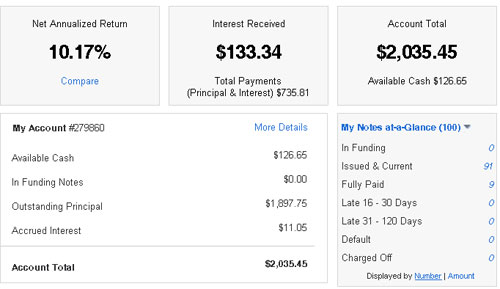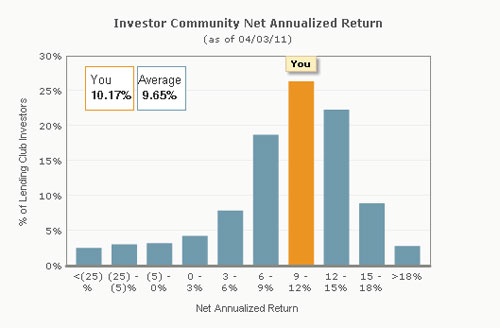I‘ve been investing in Lending Club for quite a while now and I’ve been pretty happy with how well it has performed. To be honest it has done better than my expectations. My returns are better than what I would get in a a high yield savings account, while at the same time helping others to get loans at lower rates than they would get at a traditional bank or via a credit card. It’s a great way to consolidate higher interest debt. Peer to peer lending is only going to get bigger from here I think.
Check out my original Lending Club review and my post on my Lending club investing strategy.
It’s been about 3 months since I did an update, and I thought now would be a good time to do an update on my riskier lending strategy that I’ve implemented in the past 5-6 months.
Lending Club Returns Above 10%
So here’s a quick look at the returns I’ve been seeing lately
- My Net Annualized Return is 10.17%: Up from 9.64% in January that number puts me in the 49th percentile. That means my return is higher than 49% and lower than 51% of all investors. My goal is to be doing better than 1/2 of Lending Club users, and I’m almost there!
- Zero defaults: Last time I reported my Lending Club returns, I was showing zero defaults, but had one borrower in the grace period. According to Lending Club that borrower was promising payment, and they’ve now had a couple of months of on time payments. That’s good news.
- Nine loans have been paid off early: Seven were A grade loans, and the other two were C grade loans. Looks like grade A loans might be harder to make money on because the borrowers also tend to pay off early!
- My account balance has continued to increase as I become more comfortable with using Lending Club as part of my investing strategy. I currently have $2,035.45 in my account, and I’m slowly adding more most months.
- I’m still diversified by investing across a large number of loans with no more than $25 in each loan. That way if I do have defaults, while my return may go down, my risk will be minimized.
So my strategy of adding a few choice hand picked and riskier loans seems to be paying off as I’m seeing my returns increase from where they were 6 months ago.
Low Grade Loans Can Have Good Returns
My returns that I’ve been seeing are slowly improving as I’ve taken on a new investing strategy suggested by Matt at steadfastfinances.com. He started a Lending Club investing club where he sends out hand picked high risk loans every month by email. He invests in lower grade borrowers who he has deemed to be acceptable risks. The loans he chose were Grade C or D for the most part, and while their credit scores weren’t necessarily the best, Matt felt that they were acceptable investment risks because they all had good professions, solid job history and security, and good payment histories.
Over the last 5-6 months I’ve been using this strategy to see if I can get my net annualized return up above 11-12% based off of his suggestions in his Lending Club investing club. So far I’ve gotten my returns to rise from somewhere around 8.5% up to where it is now above 10.17%. So I’m slowly inching towards that 11-12% I was shooting for. Who knows, maybe one day I’ll be near the 14.11% Matt is currently seeing.
It should be noted that Matt has now had several defaults on his loans and is adjusting his strategy a bit. Luckily I haven’t had any defaults, in part I think because I cherry picked only higher income borrowers from his suggestions.
Here’s where my NAR stands now, slightly above average. I hope to move up a couple of columns there:
Lending Club Strategy
My strategy I used in the past for Lending Club, and the strategy I’ll still be using to some degree:
- Less than $10,000: I believe I’ll still be sticking with mostly loans below $10,000. Lower amounts mean higher likelihood of payback of the loan.
- Zero delinquencies: Again, I may fudge slightly on this one, but I still want it to be very few or zero delinquencies.
- Debt to income ratio below 20-25%: I like to invest in loans where the borrowers have a lower DTI ratio, and preferably have higher incomes. I’ll try to keep this as is.
- Loans over 60% funded: When other people have invested in the loan, a lot of the times that means that they’re a better risk because others have done their due diligence and agreed to invest. Not always the case though so be careful.
- Borrower answers to investor questions: I like to ask questions from potential borrowers. You can tell a lot about someone, and about how they’ll do repaying the loan, by how they answer the questions.
So that’s the basic strategy that I’m using to invest in Lending Club right now. What strategy are you using to invest? I’m curious to know what is and isn’t working for all of my readers.
Not ready to invest, but looking to consolidate debt or pay off a high interest credit card? You might want to consider borrowing from Lending Club. Check out my post on borrowing from Lending Club.
Are you currently investing in Lending Club? How are your returns looking? Tell us in the comments!




Pete, are you using Lending Club as an alternative to high yield bonds in your portfolio?
I don’t have any debt that is right for a Lending Club consolidation loan but I have been considering joining LC as an investor and using it as a replacement to the high yield bonds I am invested in.
I’ve been using Lending Club mainly as a fun diversion up until this point – not really replacing anything except some extra money I could do without. Given the performance so far though I may have to start considering having it as a larger part after reaching other savings goals.
Gotcha Pete, I have been thinking about moving some “fun money” into LC to see if I like it. 10% is a nice return and I like the idea of helping others that LC provides.
Very cool update Peter! I see both you and Matt are doing pretty well! You have officially convinced me to start lending through this investment vehicle. You just can’t beat those percentages. Thanks for the info.
Good looking returns Pete… keep up the good work.
@Chris: I too began using Lending Club with “extra money” but soon found it to be a solid investment vehicle for high returns and continue to fund it every month.
Peter,
Great update and congrats on your increasing NAR. I just want to make one point about the comparison chart you displayed and referenced in your first point. I have spoken to the Lending Club CEO about this comparison chart because I believe it is pretty useless. Why? Because while it compares your total balance and average loan size to others it DOES NOT compare your loan age with others. So, if you have older loans with some defaults you are being compared to people with brand new loans that have no possibility of defaulting.
Now, in your case with no defaults (great effort by the way) it doesn’t make as big a difference. But I have over 1,700 loans with several defaults and it makes a big difference. The Lending Club CEO agrees that the comparison chart is flawed, so expect to see something different here in the near future.
I agree about the charts, you make some valid points. I’m glad to hear they’re working on some updated reporting.
Good job on the increasing returns! I’m not up to your level yet, but I’ve also increased my returns to 9.68%.
My only issue is that I have one loan in the (16-30) day late period. It is a C-grade loan, but I wasn’t expecting this with their 750-779 credit score to begin with.
After this experience I’m starting to be more strict with my selection criteria as well.
But it’s nice to hear that your late-paying borrower caught up. What grade was that loan?
The loan that was late originally started out as an A grade investor with a credit score over 750. If you look at the borrower’s credit score now, it has dropped drastically so something obviously happened. At least they’ve caught back up now and are current – hopefully it’ll stay that way. Just goes to show you never know which loan will go bad I guess – an A grade good credit loan or a D grade. Go figure.
Matt,
One other strategy to mention… you may want to consider looking at loans that will mature soon (e.g. in the next 1-3 years).
Great job Peter!
I have about 985.00 in Prosper—but it is not doing this well.
I am thinking of selling my loans in Prosper and change them to Lending Club.
I’ve never used prosper but from the people I’ve talked to they haven’t seemed to have as good of luck over there. Are their lending standards pretty lax?
Prosper used to be really bad. Their default rate was nearly 40% for loans issued in 2006 and 2007. Yikes! But since they reopened from their quiet period in July 2009 they have really lifted their game. I am getting over 20% on my money there with no defaults (mind you my average loan age is only six months). Overall, they still target higher credit risk people than Lending Club, so you should expect a slightly higher default rates, but I think they are a valid alternative to Lending Club.
Brad, how long have you been investing in Prosper? What grade are your loans? What is your average loan size? What selection criteria do you use? Don’t get me wrong, I am a big fan of Lending Club, but before abandoning Prosper I would take a good look at your portfolio and see if you can learn something.
I have invested 10k in Lending Club and added a couple thousand more over about a year and a half now. It has returned right around 10% after the Lending Club 1% fee. I have been VERY impressed with the site and it’s functionality for searching/sifting through the loan applications.
I also really love the Trading Platform you can sign up for to buy/sell notes. I’m currently using a strategy where I sell late notes for a loss, but avoid any chance of full default.
My own personal advice: I’d be wary of investing in Lending Club until you have more than 3000 dollars to throw at it separated into the minimum 25 dollars per loan. Otherwise, in my opinion, you just don’t have enough loans to reduce risk of default losses to the point almost no risk of losses. Your rate of return will fluctuate, but very small chance of actual losses.
This is very interesting to see these companies grow. I just posted a blog on how I see the peer to peer industry gradually replacing banking.
Would love to hear your thoughts.
http://www.simondixon.org/peer-to-peer-lending-will-it-replace-banking/2011/03/27/
Simon Dixon
Hey Peter. What are your thoughts moving all or a portion of your emergency fund into Lending Club? It seems like a great investment opportunity and I only earn 1.17% in my Money Market currently.
I haven’t really done that myself preferring to keep it mostly liquid – not tied up in a 3-5 year loan, but I believe some folks have done that. For now I’m mainly keeping “fun money” there.
Thanks Peter, I think I will keep it liquid for now too.